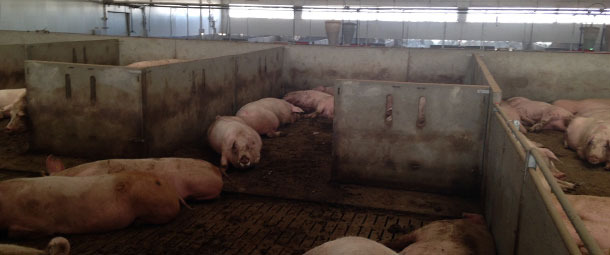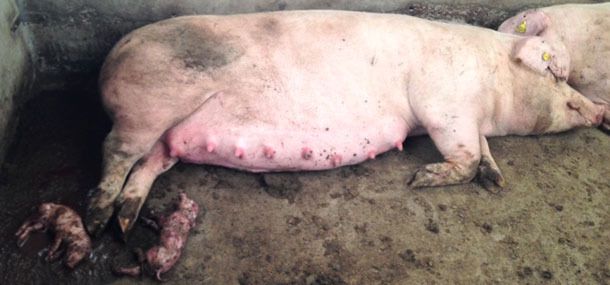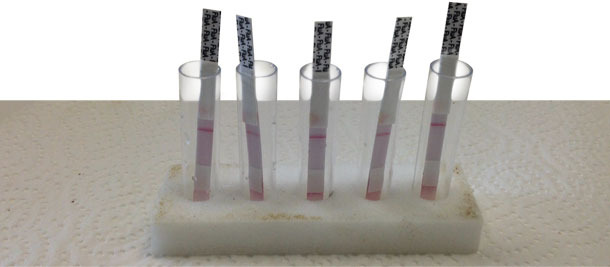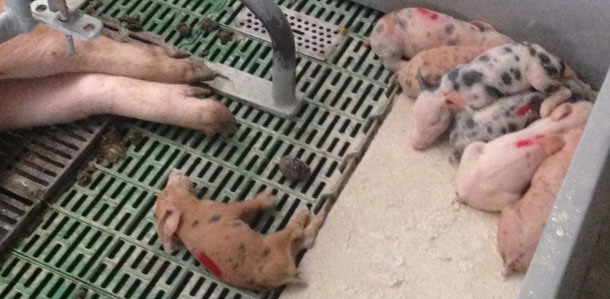The case that I will now describe started last November 2013 in Balaguer (province of Lleida, northeast of the Iberian peninsula). It is a farm for the production of piglets of 18 kg LW. At present there are some 1,000 productive sows.
This farm produces its own replacement gilts, but taking advantage of the animal welfare law (Directive 2001/88/EC), it was decided to increase its capacity from 600 to 1,200 sows. This entailed the introduction of replacement gilts from an outer source. The last batch entered the farm in May 2013. We housed, in an external quarantine facility, 100 F1 and 500 F0 sows of around 5.5 months of age and PRRS-negative. After one week of isolation, the PRRS, influenza, PPV, erysipelas and Mycoplasma vaccination plan was carried out. The new sows entered the farm in August, after spending 10 weeks in the external quarantine facility, and they started to be inseminated.


Group-housing pens for pregnant sows adapted to meet the requisites of the animal welfare law
The accumulated average production during this year (2013) is 28.2 weaned piglets per sow and year. It is a farm with very good results, and even more bearing in mind that it does not have hyperprolific genetic lines.
The health status of the farm is PRRS-positive and Mycoplasma hyopneumoniae-positive.
Vaccination plan
The sows are vaccinated against PRRS with a live vaccine at 7 days after farrowing and at 50 days of gestation. Four years ago, blanket vaccinations were performed, but we decided to change to a vaccination according to the reproductive cycle of the sows.
We also vacccinate against influenza, parvovirus-erysipelas and Aujeszky's disease.
The piglets are vaccinated against Mycoplasma hyopneumoniae with a single dose and against PCV2 at 3 weeks of age.
Appearance of the clinical case
On the evening of last November 6th 2013, we received an alert due to 4 abortions. We went to the farm first time in the morning of the following day and we carried out a visit/inspection. On the same day of the visit 3 more sows aborted.

The owner showed us, in the computer, how, in the pens for the group-housing of the pregnant sows in which the abortions happened, 35% of the sows had not entered the feeding machines, when normally, at 09.00 h, at least 90% of them have entered these machines.
We went to the gestation area and we checked how many sows (approximately 50%) were listless and showed a high temperature (39.5-40.5 ºC). We took a blood sample from 4 sows that had aborted during the previous days.
The first 4 abortions affected sows between 53 and 102 days of gestation. The rest of the sows on the farm, the farrowing quarters and the weaning stage had a normal appearance.
We send the blood samples to the laboratory, made a pool of the 4 samples, and at noon, the PCR test for PRRS gave a positive result.
The high prevalence, the moderate fever, and the speed with which the animals got sick made us suspect of influenza too.
The gilts and nuliparous F0 sows are in pens that are not the same than the pens for the multiparous sows, but they share the same building. The first group of pens was not affected.
With these results, a doubt arose. One of the sows that aborted at 53 days of gestation had been vaccinated with a live PRRS vaccine on Monday, two days before the abortion, so we asked the laboratory to carry out, that same Friday, a PCR of the vaccinated sow and a pool with the samples of the remaining 3 sows.
We obtained these results that same Friday at 16.00 h. The PRRS PCR test was negative for the pool and positive for the vaccinated sow. What then? Was PRRS the culprit for the abortions? Or did the vaccinated sow abort due to a possible vaccine adverse reaction and this had nothing to do with the other 3 abortions?
We lacked information, but on Friday (two days after the first outbreak), 6 more sows aborted. In this case they were in their 88th-105th day of gestation). Five sows had a slightly premature farrowing and farrowed at 110 days of gestation.

Premature farrowings in the pens for the group housing of the pregnant sows
On Saturday there were 13 abortions more, and 4 more sows had premature farrowings. The sows had fever (38.8-40.5 ºC). Things were not looking good at all. We went to the farm on Saturday morning, we took 15 blood samples from the tails of the sows in the pens for the group-housing of the pregnant sows, because of the fever, many sows did not even move when we handled their tail.
We implemented an antipyretic treatment with paracetamol at the highest dose during the pregnancy period, specifically some 60 mg/ kg LW/ day, because water intake was lower than normal due to the fever. In the pens for the group housing of the pregnant sows that were near to their farrowing there were many sows with fever, and we treated the most affected ones with injectable ketoprofen. The weekend ended with 21 abortions.
Monday morning, first time in the morning, we handed the samples to the laboratory, and after that we returned to the farm. The sows had a lower temperature (none of them had a temperature higher than 39.5 ºC). The sows that had to farrow during the weekend were starting to do so as of their 110th day of gestation. The piglets were obviously immature and most of them died.
We decided to take nasal swabs from the sows that aborted and we performed a FluKit in situ. The result was negative. We sent the nasal swabs to the laboratory to perform a swine influenza PCR test.

On-farm swine influenza diagnosis.
At 15.00 h. the test results of the blood samples taken on Saturday and that we handed to the laboratory first time in the morning arrived.
Our suspicions obtained an explanation. The laboratory sent the results of the PCR tests and all the pools were PRRS positive. That same evening we performed a blanket vaccination on the farm with a PRRS live vaccine, and we alerted the neighbouring farms. This was a measure taken together with the UdL (University of Lleida) and the GSP (swine health association), because we think that health is a matter that affects everybody, and the veterinarians of all the companies/farms must work together towards the good swine health in the area.
On Tuesday, the results of PCR tests of all the nasal samples were negative to swine influenza.
We must highlight the speed and efficacy of the diagnostic laboratories. Before, obtaining of the results was slower. At present, after 24 hours at the most we obtain the results, and this makes them a very good tool for the making of decisions.
During this week (46th week), there was a flow of abortions: 14 in total. The problem reached the farrowing quarters. The prolificacy fell under 10 live born piglets and the mortality in the farrowing quarters was close to 20%.

Drop in prolificacy and viability of the litters affected by the outbreaks, with piglets with clear signs of hypothermia and starving.
In week 47 there were 6 abortions more and the premature farrowings carried on.
In week 48 the process seemed to slow down. There were no abortions and the farrowings seemed to recover.
We implemented the following measures:
- Euthanize the non-viable piglets.
- Limit fosterings to the first 72 h of life, and not taking any piglets from one room to another one.
Four weeks after the blanket vaccination against PRRS, we carried out a booster vaccination. We made this decision because when carrying out the first blanket vaccination there were many sows with fever and we thought that their response to the vaccination may had not been the expected one. Our goal was to cut off the viraemia, and this measure seemed good to us.
We moved the vaccination of the piglets against Mycoplasma and PCV2 to their 5th week of age. We carried out his measure during four weeks, and after that we returned to the vaccination at 3 weeks of age, because we understood that the viraemic pigs are not in the farrowing quarters, but in the nursery stage.
As of the 30th day of the blanket booster vaccination against PRRS we will carry out a PCR test of the piglets in the farrowing quarters to check that we do not have viraemic piglets with respect to PRRS in this stage.
Once we have non-viraemic pigs in the farrowing quarters (this is, with a PRRS negative PCR test result) we will try to empty the nursery site.
This farm had not suffered any reproductive acute outbreak in the 10 years that we have been working with it. We suffered several recirculations of respiratory diseases in the nursery stage and at the start of the fattening period, but never an outbreak of abortions.
Maybe, the origin of the outbreak was the introduction of the external replacement animals in order to increase the census. This could have destabilized the farm. Anyhow, currently, the new sows' batch, that received their insemination in August, September and October, has suffered almost no abortions and their farrowings are being good.
Because of my experience with other PRRS outbreaks on other farms, there was a great difference between this outbreak and the previous ones, and that confused us at the beginning: the speed at which the sows got sick and the fever they had. We considered that the transmission of the virus was slow, but the animal welfare and the group housing make that the mouth and nose contact between the sows is higher and, because of this, the transmission is quicker than when we housed the sows in stalls. Due to this, us veterinarians should also adapt to animal welfare.
Currently (by the end of 2013) the reproductive issue seems solved and the farrowings are becoming stabilised, but we are finding piglets with ataxia in the farrowing quarters. We will start the new year fighting in the nursery stage.







